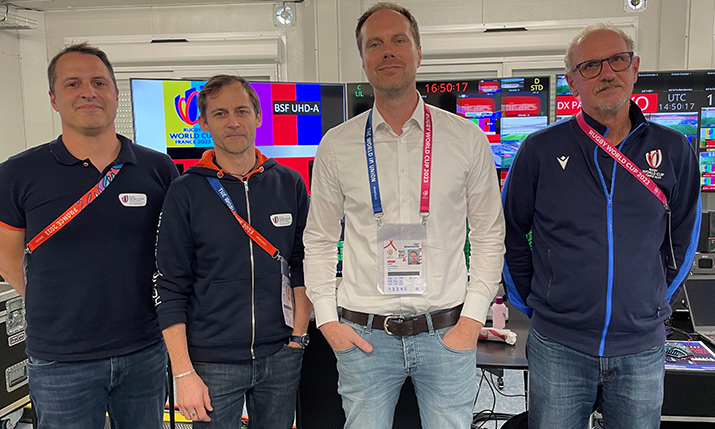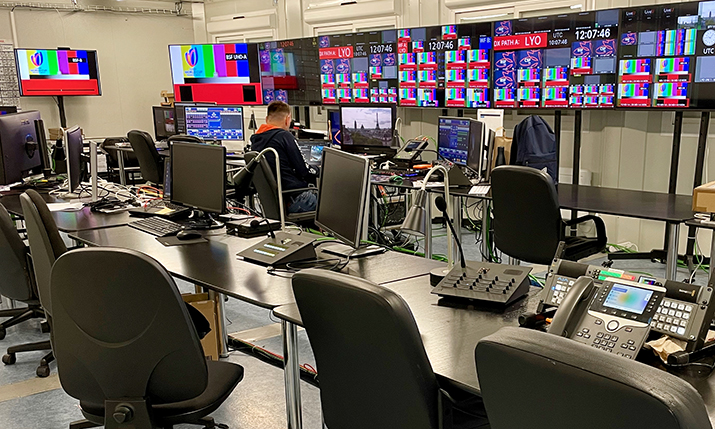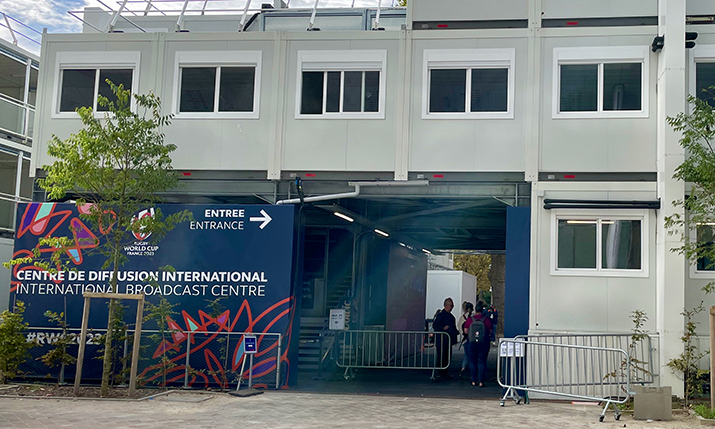Live from the Rugby World Cup 2023: Inside the infrastructure and connectivity set-up for the host broadcast operation

(left ro right) Nicolas Brie, engineering manager at Host Broadcast Services (HBS); Etienne Godart, head of live broadcast solutions, HBS; Bart Lucassen, director of engineering, HBS; Chris Hope, head of tournament and venue technology, World Rugby
A staple of the Rugby World Cup production is the multi-feeds concept, which sees several live feeds being made available to rights holders via the host broadcast operation.
The Basic Stadium Feed, the main match feed from which the World Feed is derived, starts its running order 100 minutes before the matches kick off, and concludes 65 minutes after the final whistle, ensuring comprehensive coverage is provided before and after the game – reflecting the appetite from broadcasters and their audience for buildup and review content to feed their productions.
A total of seven feeds, including three isolated camera feeds, are available for this event.
The IBC that is the hub of this operation is based at Roland-Garros, utilising buildings, facilities and infrastructure that are normally used for coverage of the French Open tennis.
In this Q&A, we find out more about the infrastructure and connectivity set-up for the host broadcast operation.
SVG Europe: How are signals handled during the RWC 2023?
Chris Hope, head of tournament and venue technology, World Rugby: RWC 2023 is distributed across multiple cities. The delivery model very much relies on Orange for the bulk of our IP data network connecting all of the match venues, while at the International Broadcast Centre (IBC), the IP data network is provided by the Fédération Française de Tennis (FFT). We have endeavored to use existing infrastructure and extend it rather than overlay a whole lot of new stuff. From a sustainability point of view, this was one of the main reasons for choosing this particular site for the IBC. The facilities here at the IBC, and at the Main Media Centre, bring up lots of synergies and efficiencies, it means we are not building something from scratch as they are already here.
SVG Europe: Tell us about the IBC and the movement of broadcast content
Bart Lucassen, director of engineering, Host Broadcast Services (HBS): We have a broadcast contribution network in place which, the same as the data network, is provided by Orange. The transport network consists of two 100Gb redundant and diverse links between the IBC and each stadium. We put our own overlay network on top of that, creating a converged network where we have video, audio and data for broadcast purposes, converging on the same network. For the 2110 side of the network we use a new technology, deploying LAWO .Edge equipment. These are SDI gateways that we put at the stadiums and at the IBC, allowing us to build a long-haul 2110 network. It’s effectively just one large network that we built here, which is working quite well. The technology was only released at IBC Amsterdam, but we have taken time to test it in advance and this is the first large-scale deployment of that technology.
Etienne Godart, head of live broadcast solutions, HBS: At the IBC we have a full 2110-based system that we have been using for a few years. It’s a decentralised network and we have two endpoints: one is dedicated to the handover to the broadcasters, which is separate from our main core system because we know for safety reasons we can check off our system if there is anything happening in cabling or handover. The system is driven from our MCR, where we control all the streams on the network layer. We are able to monitor what is actually feeding customers. Installation on-site took three weeks, but the system was pre-built and thoroughly tested before installation.

SVG Europe: How has it gone?
Lucassen: It’s gone very well. Of course, with new technology, you have challenges. But we have on-site support from the manufacturer here and also support from the lab in the UK. You run into issues whenever you have a new technology and because it’s the first time we have used it on a long-haul transport network we had to find out what the right buffer sizes were, for example, for protection. That’s something we had to tinker with to get right. This is difficult to test in a lab environment where you don’t have a real network in place. Obviously, we did a test in advance with links towards Bordeaux, but then these specific issues didn’t occur. We only found out on-site. And that’s when you need to respond quickly to make sure that it doesn’t impact the production, which we did.
If the protection doesn’t work, effectively you lose your redundancy and you’re actually working on a single leg, which is a risk. Potentially if you can’t fix that in time, you’re at a degraded service level.
SVG Europe: How do you monitor the network?
Lucassen: We have a separate provider for the end-to-end monitoring. This is because with the transport network that we have put in place, the last active equipment is at the Point of Presence (PoP), with a passive extension to the stadiums. This means that the monitoring capability for Orange is actually from the nearest PoP to the stadium to the nearest PoP to the IBC. But we want to have end-to-end monitoring of course so what we have put in place is an over-the-top monitoring system, which is provided by VIDI. They’re here on site. We have edge switches here at the IBC and at the stadiums. And they are actually monitoring from that switch to the switch here. So there is end-to-end monitoring that comes on top of the optical transport network (OTN) monitoring that Orange provides.

SVG Europe: Does the set-up differ from the Rugby World Cup 2019 in Japan?
Lucassen: One main difference for me is the streaming distribution of content. In Japan, we didn’t offer streaming services but we’re actually now offering SRT streaming of all the multi-feeds that we create here towards broadcasters, so we have three edge nodes, one in Sydney, one in London and one in Pittsburgh, where broadcasters can actually access all the content which is available in the IBC remotely. This is something which has had a good pick-up.
SVG Europe: Have you faced any different challenges to Japan?
Lucassen: The language barrier has been a challenge. Not internally but when we are liaising with local entities. In Japan, of course, you kind of know that there’s going to be a language barrier and so you have translators to support you. We didn’t expect to need translators in France, but we do have, for example, a translator here at the IBC to make sure that we can liaise with the technical staff on site. It’s been a bit of a challenge.
We can cope with most things though. There is a very good team behind this. There’s a very good collaborative spirit internally between HBS and World Rugby, but also with our tech providers. That makes or breaks an event.
The 2023 Rugby World Cup continues in France until Saturday 28 October.
Read more:
- Live from the Rugby World Cup 2023: World Rugby and HBS offer up additional content for rights-holding broadcasters
- Live from the Rugby World Cup 2023: Consistency and simplicity are key for host broadcast match coverage
- Live from the Rugby World Cup 2023: Referee mic plays crucial role in capturing atmosphere and ambience
- Live from the Rugby World Cup 2023: Digital content production offering proves popular with broadcasters and ‘TikTok Generation’ alike
- Live from Rugby World Cup 2023: Environmental sustainability underpins all World Rugby and HBS production efforts and decision-making

